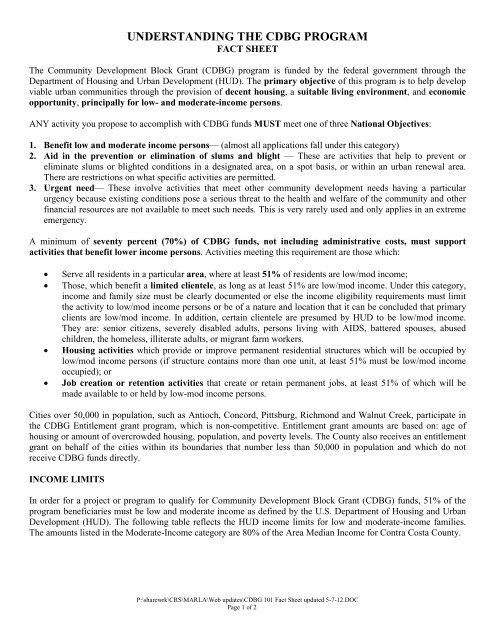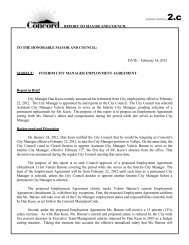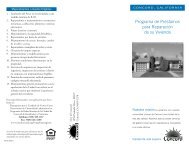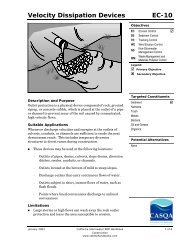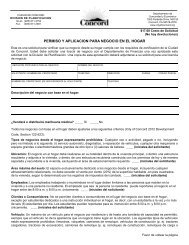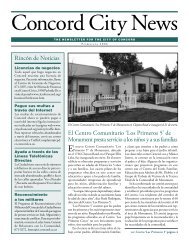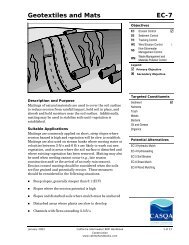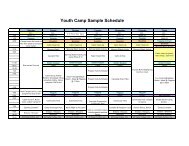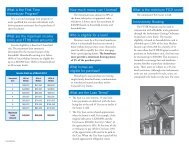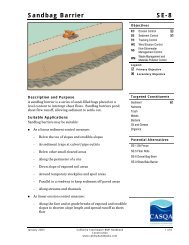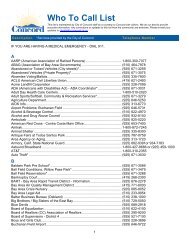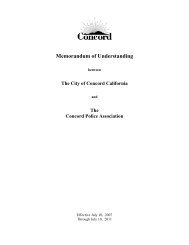CDBG Fact Sheet - City of Concord
CDBG Fact Sheet - City of Concord
CDBG Fact Sheet - City of Concord
Create successful ePaper yourself
Turn your PDF publications into a flip-book with our unique Google optimized e-Paper software.
UNDERSTANDING THE <strong>CDBG</strong> PROGRAMFACT SHEETThe Community Development Block Grant (<strong>CDBG</strong>) program is funded by the federal government through theDepartment <strong>of</strong> Housing and Urban Development (HUD). The primary objective <strong>of</strong> this program is to help developviable urban communities through the provision <strong>of</strong> decent housing, a suitable living environment, and economicopportunity, principally for low- and moderate-income persons.ANY activity you propose to accomplish with <strong>CDBG</strong> funds MUST meet one <strong>of</strong> three National Objectives:1. Benefit low and moderate income persons— (almost all applications fall under this category)2. Aid in the prevention or elimination <strong>of</strong> slums and blight — These are activities that help to prevent oreliminate slums or blighted conditions in a designated area, on a spot basis, or within an urban renewal area.There are restrictions on what specific activities are permitted.3. Urgent need— These involve activities that meet other community development needs having a particularurgency because existing conditions pose a serious threat to the health and welfare <strong>of</strong> the community and otherfinancial resources are not available to meet such needs. This is very rarely used and only applies in an extremeemergency.A minimum <strong>of</strong> seventy percent (70%) <strong>of</strong> <strong>CDBG</strong> funds, not including administrative costs, must supportactivities that benefit lower income persons. Activities meeting this requirement are those which:• Serve all residents in a particular area, where at least 51% <strong>of</strong> residents are low/mod income;• Those, which benefit a limited clientele, as long as at least 51% are low/mod income. Under this category,income and family size must be clearly documented or else the income eligibility requirements must limitthe activity to low/mod income persons or be <strong>of</strong> a nature and location that it can be concluded that primaryclients are low/mod income. In addition, certain clientele are presumed by HUD to be low/mod income.They are: senior citizens, severely disabled adults, persons living with AIDS, battered spouses, abusedchildren, the homeless, illiterate adults, or migrant farm workers.• Housing activities which provide or improve permanent residential structures which will be occupied bylow/mod income persons (if structure contains more than one unit, at least 51% must be low/mod incomeoccupied); or• Job creation or retention activities that create or retain permanent jobs, at least 51% <strong>of</strong> which will bemade available to or held by low-mod income persons.Cities over 50,000 in population, such as Antioch, <strong>Concord</strong>, Pittsburg, Richmond and Walnut Creek, participate inthe <strong>CDBG</strong> Entitlement grant program, which is non-competitive. Entitlement grant amounts are based on: age <strong>of</strong>housing or amount <strong>of</strong> overcrowded housing, population, and poverty levels. The County also receives an entitlementgrant on behalf <strong>of</strong> the cities within its boundaries that number less than 50,000 in population and which do notreceive <strong>CDBG</strong> funds directly.INCOME LIMITSIn order for a project or program to qualify for Community Development Block Grant (<strong>CDBG</strong>) funds, 51% <strong>of</strong> theprogram beneficiaries must be low and moderate income as defined by the U.S. Department <strong>of</strong> Housing and UrbanDevelopment (HUD). The following table reflects the HUD income limits for low and moderate-income families.The amounts listed in the Moderate-Income category are 80% <strong>of</strong> the Area Median Income for Contra Costa County.P:\sharewrk\CRS\MARLA\Web updates\<strong>CDBG</strong> 101 <strong>Fact</strong> <strong>Sheet</strong> updated 5-7-12.DOCPage 1 <strong>of</strong> 2
PRIORITIES FOR <strong>CDBG</strong> PROGRAMLocalities identify pressing needs for their communities in their Consolidated Plan and through the Public Hearingprocess. Jurisdictions are free to select those activities to fund with <strong>CDBG</strong> monies that best meet the needs <strong>of</strong> theircommunity in accordance with their Consolidated Plan, the national objectives and requirements <strong>of</strong> the <strong>CDBG</strong> programand their local objectives.ELIGIBLE ACTIVITIESCONTRA COSTA COUNTY CONSORTIUM<strong>CDBG</strong> PROGRAMIncome Limits by Household Size - Effective December, 2011Maximum income <strong>of</strong> households which are:Persons per Household Extremely Low-Income Very-low Income Low Income Median Income1 $19,650 $32,750 $45,750 $65,5002 $22,450 $37,400 $52,300 $74,8003 $25,250 $42,100 $58,850 $84,2004 $28,050 $46,750 $65,350 $93,5005 $30,300 $50,500 $70,600 $101,0006 $32,550 $54,250 $75,850 $108,5007 $34,800 $58,000 $81,050 $116,0008 $37,050 $61,750 $86,300 $123,500Extremely low-income households are defined as households earning 30 percent or less <strong>of</strong> area median income (AMI) ; verylowincome households earn 50 percent or less AMI; low-income households earn 80 percent or less AMI subject to HUDcaps; and median income households earn 100 percent AMI.Source: U.S. Department <strong>of</strong> Housing and Urban Development.A wide variety <strong>of</strong> activities are eligible for <strong>CDBG</strong> funding. Eligible activities that may be proposed for funding will fallinto one <strong>of</strong> six categories:• Public Services - such as shelter for battered women and children; health care and substance abuse services;programs to help prevent or address homelessness; crime prevention; fair housing counseling; job training; servicesfor the elderly, disabled, or disadvantaged youth; etc. Funding in this category is limited by federal law to amaximum <strong>of</strong> 15% <strong>of</strong> a locality’s annual <strong>CDBG</strong> entitlement grant.• Housing Activities - rehabilitation and preservation; lead-based paint testing and abatement; construction <strong>of</strong> lowincomehousing by Community Based Development Organizations (CBDOs); clearance and demolition; etc.• Economic Development - activities which will result in jobs for low-income individuals, such as assistance to microenterprisesand other businesses; acquisition, construction and rehabilitation <strong>of</strong> commercial and industrial properties;outreach, marketing and other services to assisted businesses; relocation assistance for businesses temporarily orpermanently relocated; etc.• Public Facilities and Improvements - activities such as acquisition, installation, construction and rehabilitation <strong>of</strong>infrastructure (e.g., water/sewer lines, streets and sidewalks); acquisition, construction or rehabilitation <strong>of</strong>neighborhood facilities, and facilities for persons with special needs (e.g., homeless shelters, group homes andhalfway houses); etc.• Other - such as code enforcement; historic preservation; interim assistance to arrest severe deterioration or alleviateemergency conditions; completion <strong>of</strong> urban renewal projects; special activities by CBDO’s in connection withneighborhood revitalization, community economic development and energy conservation projects; assistance toinstitutions <strong>of</strong> higher education with the capacity to carry out other eligible activities, etc.• Planning and Administration - which is the general management, oversight, and coordination <strong>of</strong> the <strong>CDBG</strong> programand other related activities. Funding in this category is limited by federal law to 20% <strong>of</strong> the <strong>City</strong>’s total allocation forthe year.P:\sharewrk\CRS\MARLA\Web updates\<strong>CDBG</strong> 101 <strong>Fact</strong> <strong>Sheet</strong> updated 5-7-12.DOCPage 2 <strong>of</strong> 2


